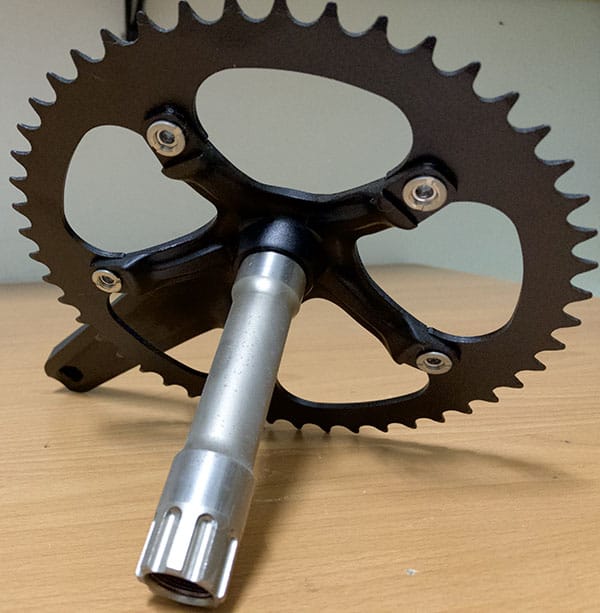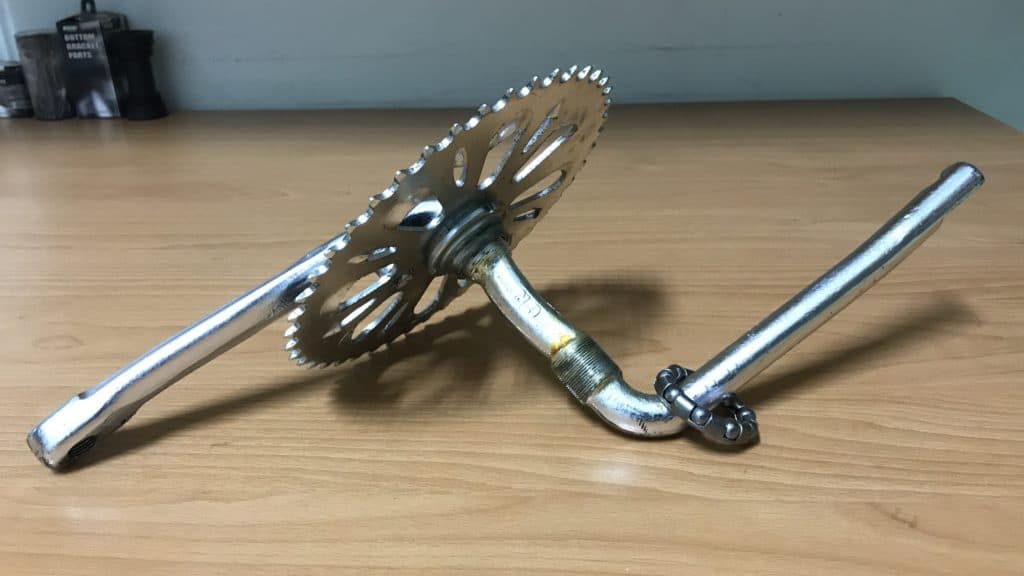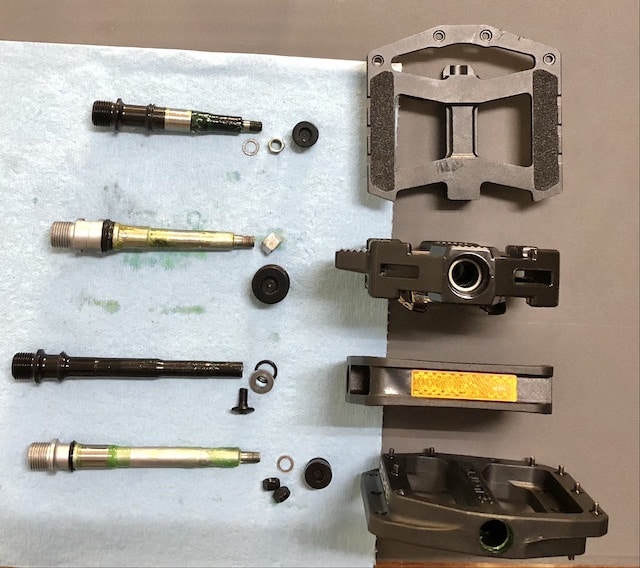Understanding the Anatomy of a Bicycle Pedal Crank
A bicycle pedal crank assembly is a complex system that plays a crucial role in the overall performance of a bicycle. It consists of three primary components: the crank arms, pedals, and bottom bracket. Each of these components works in harmony to provide a smooth and efficient riding experience.
The crank arms are the long, rod-like structures that connect the pedals to the bottom bracket. They are typically made of strong, lightweight materials such as aluminum or carbon fiber, which provide the necessary strength and stiffness to transfer power from the rider’s legs to the wheels. The pedals are the platforms that the rider’s feet rest on, and are usually attached to the crank arms via a pedal axle. The bottom bracket is the component that connects the crank arms to the bicycle frame, and is responsible for supporting the entire pedal crank assembly.
The importance of each component cannot be overstated. The crank arms provide the leverage needed to transfer power from the rider’s legs to the wheels, while the pedals provide a comfortable and secure platform for the rider’s feet. The bottom bracket ensures that the entire assembly is securely attached to the bicycle frame, and allows for smooth rotation of the crank arms. When all these components work together in harmony, they provide a seamless and efficient riding experience. A well-designed bicycle pedal crank assembly can make a significant difference in a rider’s performance and overall enjoyment of the ride.
In addition to their individual functions, the components of a bicycle pedal crank assembly also work together to provide a range of benefits. For example, a well-designed pedal crank assembly can improve pedaling efficiency, reduce fatigue, and enhance overall cycling performance. By understanding the anatomy of a bicycle pedal crank assembly, riders can better appreciate the importance of this critical component and take steps to optimize its performance.
How to Choose the Right Pedal Crank Assembly for Your Bike
Selecting the right pedal crank assembly for your bicycle is a crucial decision that can significantly impact your riding experience. With so many options available, it can be overwhelming to choose the right one. However, by considering a few key factors, you can make an informed decision that meets your specific needs and preferences.
One of the most important factors to consider is the type of bike you have. Different types of bikes, such as road bikes, mountain bikes, and hybrid bikes, require different types of pedal crank assemblies. For example, road bikes typically require a more lightweight and aerodynamic pedal crank assembly, while mountain bikes require a more durable and robust assembly.
Riding style is another important factor to consider. If you’re a casual rider who primarily rides on flat terrain, you may not need a high-performance pedal crank assembly. However, if you’re an avid cyclist who tackles challenging terrain and steep hills, you’ll want a pedal crank assembly that can handle the demands of your riding style.
Personal preference also plays a significant role in choosing the right pedal crank assembly. Some riders prefer a more ergonomic design, while others prefer a more traditional design. Additionally, some riders may prioritize weight savings, while others may prioritize durability.
Popular brands such as Shimano and SRAM offer a range of pedal crank assemblies that cater to different types of bikes, riding styles, and personal preferences. Shimano’s Ultegra pedal crank assembly is a popular choice among road cyclists, while SRAM’s XX1 pedal crank assembly is a favorite among mountain bikers.
When selecting a pedal crank assembly, it’s also important to consider the compatibility of the assembly with your bike’s components. Ensure that the pedal crank assembly is compatible with your bike’s bottom bracket, chainrings, and pedals.
By considering these factors and doing your research, you can find a pedal crank assembly that meets your specific needs and preferences, and enhances your overall riding experience. Remember, the right pedal crank assembly can make a significant difference in your performance and enjoyment of the ride.
The Importance of Proper Installation and Maintenance
Proper installation and maintenance of the bicycle pedal crank assembly are crucial to ensure a smooth and efficient riding experience. A well-installed and well-maintained pedal crank assembly can improve pedaling efficiency, reduce fatigue, and enhance overall cycling performance.
Installing a pedal crank assembly requires attention to detail and a thorough understanding of the components involved. It’s essential to follow the manufacturer’s instructions and take the necessary precautions to avoid damaging the components. A poorly installed pedal crank assembly can lead to premature wear, reduced performance, and even safety issues.
Adjusting the pedals is another critical aspect of pedal crank assembly maintenance. Proper pedal adjustment ensures that the pedals are securely attached to the crank arms and that the rider’s feet are comfortably positioned on the pedals. Adjusting the pedals also helps to prevent issues such as creaking or clicking, which can be distracting and affect the rider’s performance.
Regular checks and maintenance tasks are also essential to ensure the longevity of the pedal crank assembly. Riders should regularly inspect the assembly for signs of wear, such as worn-out bearings or damaged components. They should also perform routine maintenance tasks, such as cleaning and lubricating the components, to prevent corrosion and wear.
A well-maintained pedal crank assembly can also help to prevent common issues such as creaking, clicking, or loose pedals. By identifying and addressing these issues early, riders can avoid more serious problems and ensure a smooth and efficient riding experience.
In addition to proper installation and maintenance, riders should also consider upgrading their pedal crank assembly to improve performance. Upgrading to a high-performance pedal crank assembly can provide significant benefits, including increased efficiency, improved power transfer, and enhanced overall performance.
In conclusion, proper installation and maintenance of the bicycle pedal crank assembly are critical to ensure a smooth and efficient riding experience. By following the manufacturer’s instructions, adjusting the pedals, and performing regular checks and maintenance tasks, riders can optimize their pedal crank assembly and improve their overall cycling performance.
Common Issues and Troubleshooting Tips
Despite its importance, the bicycle pedal crank assembly is not immune to issues. Common problems that can arise with the pedal crank assembly include creaking, clicking, or loose pedals. These issues can be frustrating and affect the overall riding experience. However, with the right troubleshooting tips and solutions, riders can resolve these issues and get back to enjoying their ride.
Creaking pedals are a common issue that can be caused by worn-out bearings, loose pedal bolts, or misaligned pedals. To troubleshoot creaking pedals, riders should first check the pedal bolts and tighten them if necessary. They should also inspect the bearings and replace them if they are worn out. Additionally, riders can try adjusting the pedals to ensure they are properly aligned.
Clicking pedals are another common issue that can be caused by worn-out chainrings, misaligned pedals, or loose pedal bolts. To troubleshoot clicking pedals, riders should first check the chainrings and replace them if they are worn out. They should also inspect the pedal bolts and tighten them if necessary. Additionally, riders can try adjusting the pedals to ensure they are properly aligned.
Loose pedals are a safety issue that can be caused by worn-out pedal threads, loose pedal bolts, or misaligned pedals. To troubleshoot loose pedals, riders should first check the pedal threads and replace them if they are worn out. They should also inspect the pedal bolts and tighten them if necessary. Additionally, riders can try adjusting the pedals to ensure they are properly aligned.
In addition to these common issues, riders may also experience other problems with their pedal crank assembly, such as worn-out crank arms or bottom brackets. To troubleshoot these issues, riders should first identify the source of the problem and then take the necessary steps to resolve it. This may involve replacing worn-out components, adjusting the assembly, or seeking the help of a professional mechanic.
By being aware of these common issues and knowing how to troubleshoot them, riders can ensure their pedal crank assembly is functioning properly and providing a smooth and efficient riding experience. Regular maintenance and inspections can also help prevent these issues from arising in the first place. With the right knowledge and tools, riders can optimize their pedal crank assembly and take their riding to the next level.
Upgrading Your Pedal Crank Assembly for Enhanced Performance
Upgrading the bicycle pedal crank assembly can be a game-changer for cyclists looking to improve their performance. A high-performance pedal crank assembly can provide significant benefits, including increased efficiency, improved power transfer, and enhanced overall performance. By upgrading to a high-quality pedal crank assembly, riders can experience a noticeable difference in their riding experience.
One of the most significant benefits of upgrading the pedal crank assembly is increased efficiency. A high-performance pedal crank assembly can help riders to pedal more efficiently, allowing them to conserve energy and ride longer. This is especially important for riders who participate in long-distance events or ride frequently.
Another benefit of upgrading the pedal crank assembly is improved power transfer. A high-performance pedal crank assembly can help riders to transfer power more effectively from their legs to the pedals, allowing them to accelerate faster and maintain speed more easily. This is especially important for riders who participate in competitive events or ride in hilly terrain.
There are several upgrade options available for riders looking to improve their pedal crank assembly. One popular option is to upgrade to carbon fiber crank arms, which are lighter and stiffer than traditional aluminum crank arms. This can help to improve power transfer and reduce fatigue. Another option is to upgrade to titanium pedals, which are stronger and more durable than traditional steel pedals. This can help to improve pedaling efficiency and reduce the risk of pedal failure.
Other upgrade options include upgrading to a high-performance bottom bracket, which can help to improve pedaling efficiency and reduce friction. Riders can also consider upgrading to a high-performance chainring, which can help to improve power transfer and reduce wear on the chain.
When upgrading the pedal crank assembly, it’s essential to consider the rider’s specific needs and preferences. Riders should consider factors such as their riding style, bike type, and personal preferences when selecting an upgrade option. They should also consider the cost and durability of the upgrade option, as well as any potential compatibility issues with their existing bike components.
In conclusion, upgrading the bicycle pedal crank assembly can be a great way to improve performance and enhance the riding experience. By selecting the right upgrade option, riders can experience significant benefits, including increased efficiency, improved power transfer, and enhanced overall performance. Whether you’re a competitive rider or a casual enthusiast, upgrading your pedal crank assembly can help you to take your riding to the next level.
The Role of Pedal Crank Assembly in Cycling Efficiency
The bicycle pedal crank assembly plays a crucial role in cycling efficiency, as it directly affects pedaling technique, power output, and overall speed. A well-designed pedal crank assembly can significantly improve cycling efficiency, allowing riders to ride faster, farther, and with less effort.
One of the primary ways the pedal crank assembly affects cycling efficiency is through pedaling technique. A smooth, efficient pedaling motion is essential for generating power and speed. The pedal crank assembly’s design and components, such as the crank arms, pedals, and bottom bracket, work together to facilitate a smooth pedaling motion. A well-designed pedal crank assembly can help riders maintain a consistent pedaling rhythm, reducing energy waste and improving overall efficiency.
The pedal crank assembly also has a significant impact on power output. The assembly’s design and materials can affect the amount of power transferred from the rider’s legs to the pedals. A high-performance pedal crank assembly can help riders generate more power, allowing them to accelerate faster and maintain speed more easily. This is especially important for riders who participate in competitive events or ride in hilly terrain.
In addition to pedaling technique and power output, the pedal crank assembly also affects overall speed. A well-designed pedal crank assembly can help riders maintain a high speed, even on flat terrain. This is because the assembly’s design and components work together to reduce energy waste and improve pedaling efficiency, allowing riders to generate more power and speed with less effort.
A well-designed bicycle pedal crank assembly can also improve cycling efficiency by reducing energy waste. Energy waste occurs when the rider’s pedaling motion is not smooth and efficient, resulting in lost power and speed. A high-performance pedal crank assembly can help reduce energy waste by providing a smooth, efficient pedaling motion, allowing riders to generate more power and speed with less effort.
In conclusion, the pedal crank assembly plays a critical role in cycling efficiency, affecting pedaling technique, power output, and overall speed. By selecting a well-designed pedal crank assembly, riders can improve their cycling efficiency, ride faster, farther, and with less effort. Whether you’re a competitive rider or a casual enthusiast, a high-performance pedal crank assembly can help you take your riding to the next level.
Comparing Different Pedal Crank Assembly Materials and Designs
When it comes to selecting a bicycle pedal crank assembly, one of the most critical decisions is choosing the right material and design. The pedal crank assembly is a crucial component of a bicycle, and the material and design used can significantly impact the overall performance and efficiency of the bike. In this section, we’ll compare and contrast different materials and designs used in pedal crank assemblies, including aluminum, carbon fiber, and titanium.
Aluminum pedal crank assemblies are a popular choice among cyclists due to their durability, affordability, and lightweight properties. Aluminum crank arms are often used in entry-level and mid-range bicycles, providing a reliable and efficient pedaling experience. However, aluminum pedal crank assemblies may not offer the same level of stiffness and power transfer as more advanced materials, such as carbon fiber.
Carbon fiber pedal crank assemblies, on the other hand, offer exceptional stiffness, power transfer, and weight reduction. Carbon fiber crank arms are often used in high-performance bicycles, providing a responsive and efficient pedaling experience. However, carbon fiber pedal crank assemblies can be more expensive than aluminum or titanium options, and may be more prone to damage from impact or extreme weather conditions.
Titanium pedal crank assemblies offer a unique combination of strength, durability, and weight reduction. Titanium crank arms are often used in high-end bicycles, providing a smooth and efficient pedaling experience. Titanium pedal crank assemblies are also known for their corrosion resistance and ability to withstand extreme weather conditions. However, titanium pedal crank assemblies can be more expensive than aluminum or carbon fiber options, and may require specialized maintenance and repair.
In addition to material selection, the design of the pedal crank assembly also plays a critical role in its overall performance. For example, some pedal crank assemblies feature a hollow or tubular design, which can reduce weight and improve stiffness. Others may feature a compact or oversized design, which can improve power transfer and pedaling efficiency.
When selecting a bicycle pedal crank assembly, it’s essential to consider the specific needs and preferences of the rider. Factors such as bike type, riding style, and personal preference should all be taken into account. By understanding the advantages and disadvantages of different materials and designs, cyclists can make an informed decision and choose the right pedal crank assembly for their needs.
In conclusion, the material and design of the pedal crank assembly can significantly impact the overall performance and efficiency of a bicycle. By understanding the advantages and disadvantages of different materials and designs, cyclists can make an informed decision and choose the right pedal crank assembly for their needs. Whether you’re a competitive rider or a casual enthusiast, selecting the right pedal crank assembly can help you optimize your ride and take your cycling to the next level.
Conclusion: Optimizing Your Ride with the Right Pedal Crank Assembly
In conclusion, the bicycle pedal crank assembly plays a vital role in cycling, providing the foundation for a smooth, efficient, and enjoyable ride. By understanding the different components of a pedal crank assembly, choosing the right one for your bike, and properly installing and maintaining it, cyclists can optimize their ride and take their cycling to the next level.
Whether you’re a competitive rider or a casual enthusiast, selecting the right pedal crank assembly can make all the difference in your cycling experience. By considering factors such as bike type, riding style, and personal preference, cyclists can find a pedal crank assembly that meets their specific needs and preferences.
Remember, a well-designed pedal crank assembly can improve pedaling efficiency, increase power transfer, and enhance overall performance. By upgrading to a high-performance pedal crank assembly, cyclists can experience the thrill of improved speed and agility.
In the end, it’s all about finding the right balance between performance, comfort, and style. By taking the time to research, compare, and select the right pedal crank assembly, cyclists can optimize their ride and enjoy a more rewarding and enjoyable cycling experience.
So, don’t settle for a subpar pedal crank assembly. Take the time to explore your options, consider your needs, and choose a pedal crank assembly that will help you achieve your cycling goals. With the right pedal crank assembly, you’ll be pedaling your way to cycling success in no time.








